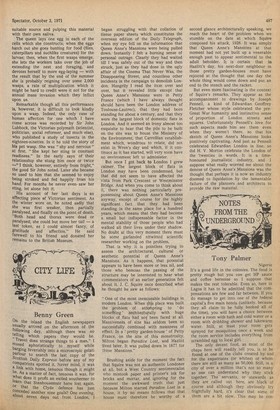Benny Green
Ou the island the English newspapers usually arrived on the afternoon of the following day, although there was no telling which papers they would be. " Travel does strange things to a man," I mused aphoristically to myself while barging feverishly into a microscopic gelati Parlour to snatch the last copy of the Scottish Daily Express before any of my compatriots spotted it. Never mind, it was a link with home, tenuous though it might be. As a matter of fact, tenuous it was, for What does it profit an exiled southerner to learn that Stenhousemuir have lost again, or that the Clyde defence has just conceded another nine goals? One evening, about seven days out from London, I began struggling with that collation of tissue paper sheets which constitutes the overseas edition of the Daily Telegraph, when my eye fell on the information that Queen Anne's Mansions were being pulled down. Instantly I felt a burning sense of personal outrage. Clearly they had waited till I was safely out of the way and then struck, just as they had done in the ugly affair of the Cinema That Never Was, the Disappearing Street, and countless other incidents in the campaign to demolish London. Hungrily I read the item over and over, but it revealed little except that Queen Anne's Mansions were in Petty France (which I have always thought should have been the London address of Toulouse-Lautrec), that they had been standing for about a century, and that they were the largest block of domestic flats in London, And it seemed an irony almost too exquisite to bear that the pile to be built on the site was to house the Ministry of the Environment, that Carrollian establishment which, wondrous to relate, did not exist in Wren's day and which, it it continues as it has started, will very soon have no environment left to administer. But once I got back to London I grew calmer. The largest block of flats in London may have been condemned, but that did not seem to have affected the vista from Park Crescent or Westminster Bridge. And when you come to think about it, there was nothing particularly prepossessing about Queen Anne's Mansions anyway, except of course for the highly significant fact that they had been standing in the same place for a hundred years, which means that they had become a small but indispensable factor in the mental stability of those people who had walked all their lives under their shadow. No doubt at this very moment there must be some garlanded nitwitted scientific researcher working on the problem.
That is why it is pointless trying to assess the architectural, cultural or aesthetic potential of Queen Anne's Mansions. As it happens, that potential appears to have been more or less nil, and those who bemoan the passing of the structure may be interested to hear what commentators of an earlier generation felt about it. J. C. Squire once described what he thought he saw as follows:
"One of the most inexcusable buildings in modern London. When this place was built the problem of attempting to do something ' architecturally with huge blocks of flats had not been faced at all. Massiveness of size has seldom been so successfully combined with meanness of effect. In a pretty garden-house' of Petty France, on the site of this monstrosity, Milton began Paradire Lost, and Hazlitt lived later. It was pulled down in 1877 for these Mansions."
Brushing aside for the moment the fact that Squire was not an authentic Londoner at all, but a West Country sentimentalist who mistook paper and printer's ink for bricks and mortar, and ignoring for the moment the awkward truth that just because Milton started Paradise Lost in a house, it by no means follows that that house must therefore be worthy of a
second glance architecturally speaking, we reach the heart of the problem when we stumble on the date at which Squire composed his attack, 1928. It was simply that Queen Anne's Mansions at that moment had not yet built up a venerable enough past to appear sentimental to the adult beholder. It is certain that in Hazlitt's day, his next-door neighbour in those pretty garden-houses must have rejoiced at the thought that one day the whole thing would come down and put an end to the stench and the racket.
But even more fascinating is the context of Squire's remarks. They appear as the accompaniment to drawings by Joseph Pennell, a kind of Edwardian Geoffrey Fletcher whose style celebrated the preGreat War humanity and instinctive sense of proportion of London streets and squares. Unfortunately Pennell's love for such aspects made him see them even when they weren't there, so that his sketch of Queen Anne's Mansions looks positively captivating. And just as Pennell celebrated Edwardian London in line, so did H. V. Morton celebrate the London of the 'twenties in words. It is a timehonoured journalistic industry, and I suppose what really worried me about the demise of Queen Anne's Mansions was the thought that perhaps it is now an industry doomed to liquidation by the lamentable failure of the planners and architects to provide the raw material.
































 Previous page
Previous page